Evaluating Innovation in Social Services and Market Adaptation
VerifiedAdded on 2020/04/01
|14
|3503
|45
AI Summary
Innovation is crucial in shaping the future landscape of businesses and industries. It involves developing new ideas or improving existing processes to stay ahead in a rapidly evolving market environment. This essay explores various dimensions of innovation, including technological advancements, organizational changes, and strategic investments. It highlights how innovation drives business transformation by enabling companies to adapt to new market demands and consumer expectations. The analysis also covers the challenges businesses face when implementing innovative strategies, such as resource allocation, risk management, and maintaining a balance between creativity and practicality. Furthermore, the essay discusses the role of innovation in social services and education, emphasizing its potential to address societal issues and enhance service delivery. By examining case studies and theoretical frameworks, this paper provides insights into how businesses can leverage innovation for long-term growth and success.
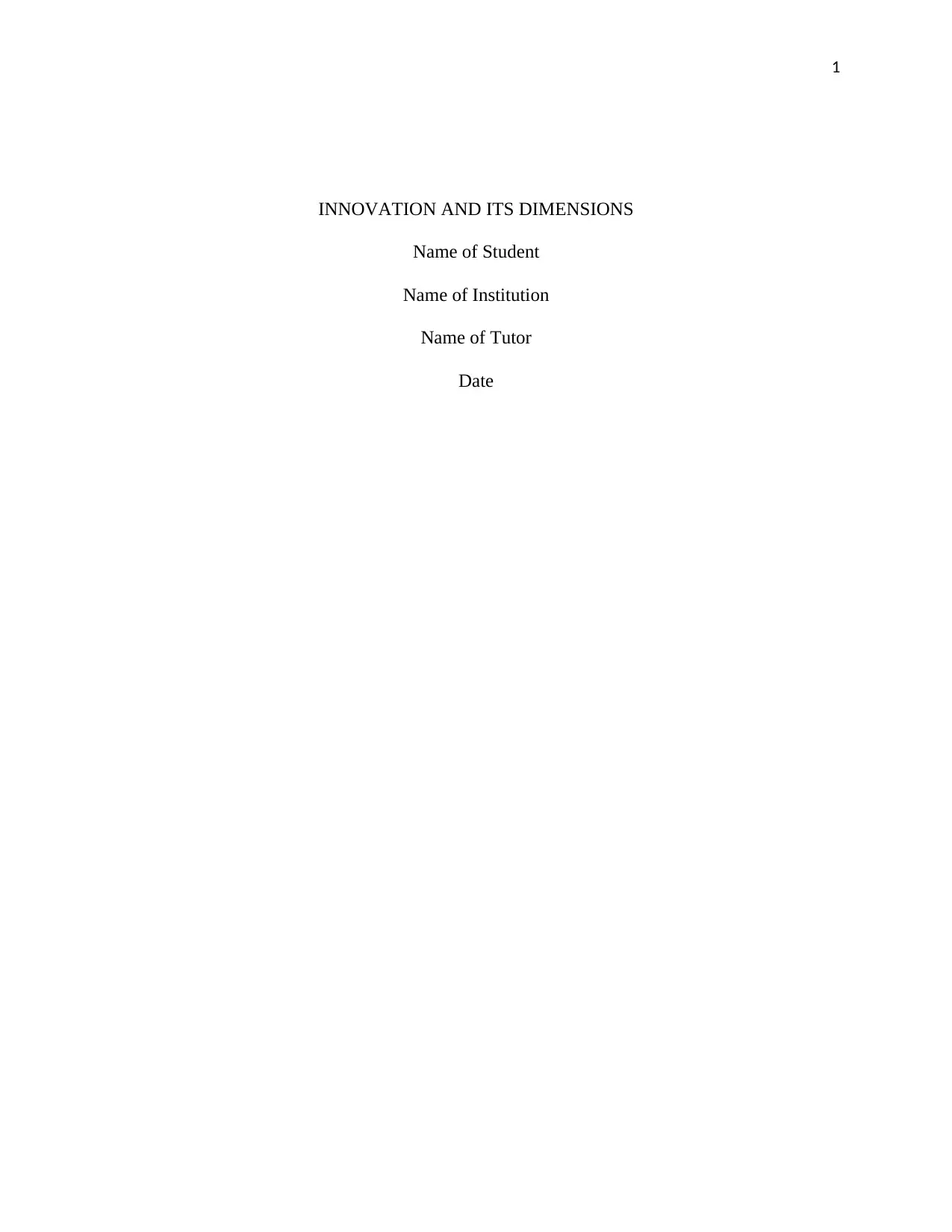
1
INNOVATION AND ITS DIMENSIONS
Name of Student
Name of Institution
Name of Tutor
Date
INNOVATION AND ITS DIMENSIONS
Name of Student
Name of Institution
Name of Tutor
Date
Paraphrase This Document
Need a fresh take? Get an instant paraphrase of this document with our AI Paraphraser
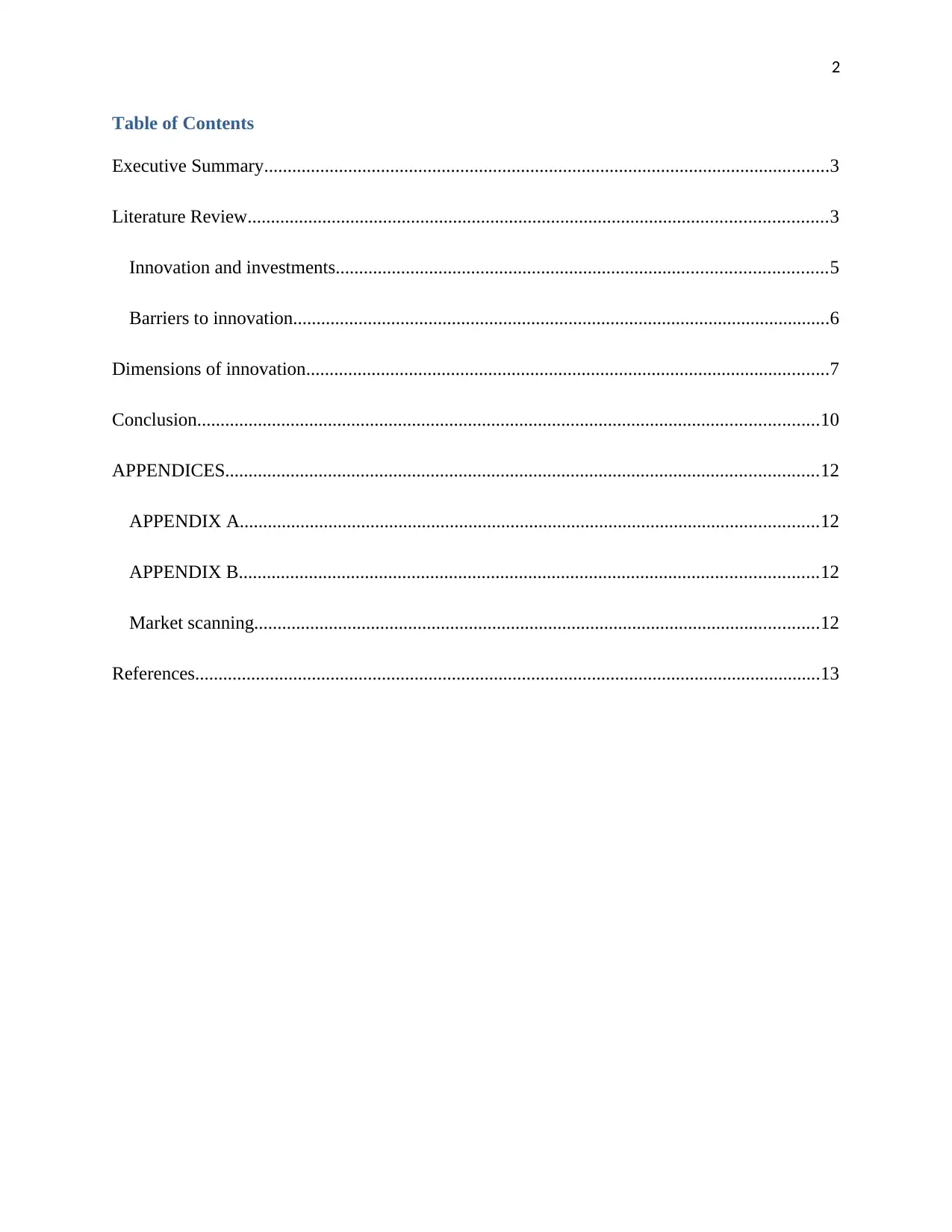
2
Table of Contents
Executive Summary.........................................................................................................................3
Literature Review............................................................................................................................3
Innovation and investments.........................................................................................................5
Barriers to innovation...................................................................................................................6
Dimensions of innovation................................................................................................................7
Conclusion.....................................................................................................................................10
APPENDICES...............................................................................................................................12
APPENDIX A............................................................................................................................12
APPENDIX B............................................................................................................................12
Market scanning.........................................................................................................................12
References......................................................................................................................................13
Table of Contents
Executive Summary.........................................................................................................................3
Literature Review............................................................................................................................3
Innovation and investments.........................................................................................................5
Barriers to innovation...................................................................................................................6
Dimensions of innovation................................................................................................................7
Conclusion.....................................................................................................................................10
APPENDICES...............................................................................................................................12
APPENDIX A............................................................................................................................12
APPENDIX B............................................................................................................................12
Market scanning.........................................................................................................................12
References......................................................................................................................................13
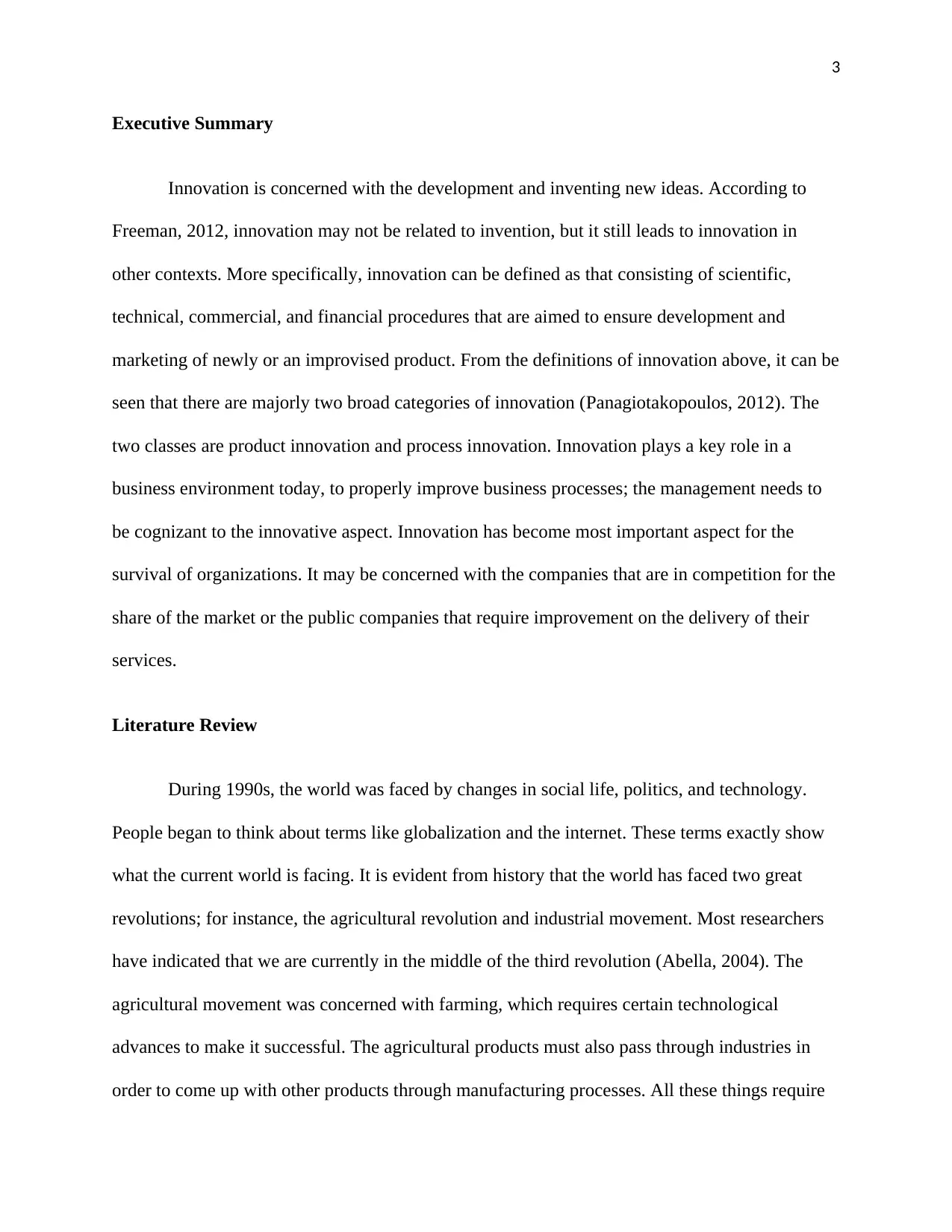
3
Executive Summary
Innovation is concerned with the development and inventing new ideas. According to
Freeman, 2012, innovation may not be related to invention, but it still leads to innovation in
other contexts. More specifically, innovation can be defined as that consisting of scientific,
technical, commercial, and financial procedures that are aimed to ensure development and
marketing of newly or an improvised product. From the definitions of innovation above, it can be
seen that there are majorly two broad categories of innovation (Panagiotakopoulos, 2012). The
two classes are product innovation and process innovation. Innovation plays a key role in a
business environment today, to properly improve business processes; the management needs to
be cognizant to the innovative aspect. Innovation has become most important aspect for the
survival of organizations. It may be concerned with the companies that are in competition for the
share of the market or the public companies that require improvement on the delivery of their
services.
Literature Review
During 1990s, the world was faced by changes in social life, politics, and technology.
People began to think about terms like globalization and the internet. These terms exactly show
what the current world is facing. It is evident from history that the world has faced two great
revolutions; for instance, the agricultural revolution and industrial movement. Most researchers
have indicated that we are currently in the middle of the third revolution (Abella, 2004). The
agricultural movement was concerned with farming, which requires certain technological
advances to make it successful. The agricultural products must also pass through industries in
order to come up with other products through manufacturing processes. All these things require
Executive Summary
Innovation is concerned with the development and inventing new ideas. According to
Freeman, 2012, innovation may not be related to invention, but it still leads to innovation in
other contexts. More specifically, innovation can be defined as that consisting of scientific,
technical, commercial, and financial procedures that are aimed to ensure development and
marketing of newly or an improvised product. From the definitions of innovation above, it can be
seen that there are majorly two broad categories of innovation (Panagiotakopoulos, 2012). The
two classes are product innovation and process innovation. Innovation plays a key role in a
business environment today, to properly improve business processes; the management needs to
be cognizant to the innovative aspect. Innovation has become most important aspect for the
survival of organizations. It may be concerned with the companies that are in competition for the
share of the market or the public companies that require improvement on the delivery of their
services.
Literature Review
During 1990s, the world was faced by changes in social life, politics, and technology.
People began to think about terms like globalization and the internet. These terms exactly show
what the current world is facing. It is evident from history that the world has faced two great
revolutions; for instance, the agricultural revolution and industrial movement. Most researchers
have indicated that we are currently in the middle of the third revolution (Abella, 2004). The
agricultural movement was concerned with farming, which requires certain technological
advances to make it successful. The agricultural products must also pass through industries in
order to come up with other products through manufacturing processes. All these things require
⊘ This is a preview!⊘
Do you want full access?
Subscribe today to unlock all pages.

Trusted by 1+ million students worldwide
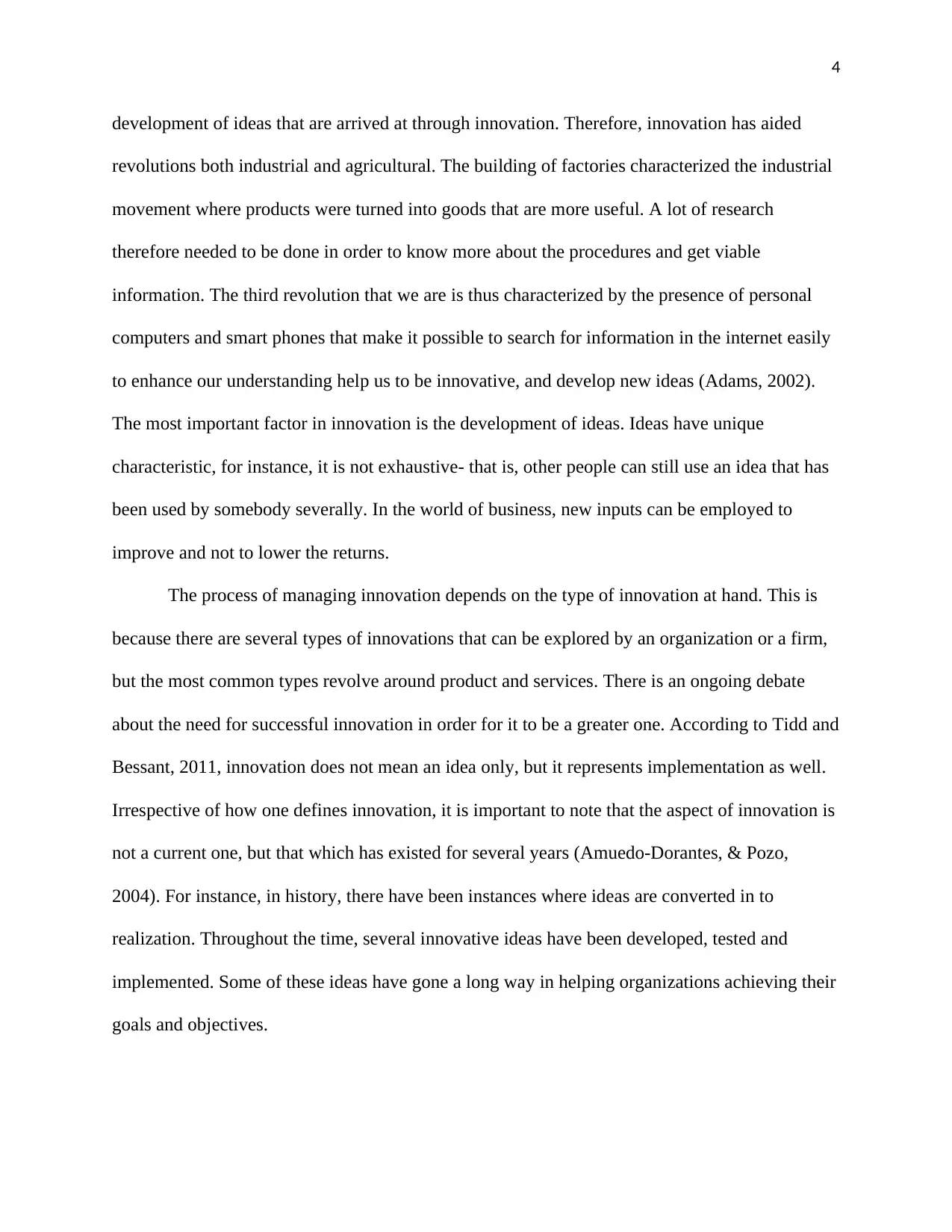
4
development of ideas that are arrived at through innovation. Therefore, innovation has aided
revolutions both industrial and agricultural. The building of factories characterized the industrial
movement where products were turned into goods that are more useful. A lot of research
therefore needed to be done in order to know more about the procedures and get viable
information. The third revolution that we are is thus characterized by the presence of personal
computers and smart phones that make it possible to search for information in the internet easily
to enhance our understanding help us to be innovative, and develop new ideas (Adams, 2002).
The most important factor in innovation is the development of ideas. Ideas have unique
characteristic, for instance, it is not exhaustive- that is, other people can still use an idea that has
been used by somebody severally. In the world of business, new inputs can be employed to
improve and not to lower the returns.
The process of managing innovation depends on the type of innovation at hand. This is
because there are several types of innovations that can be explored by an organization or a firm,
but the most common types revolve around product and services. There is an ongoing debate
about the need for successful innovation in order for it to be a greater one. According to Tidd and
Bessant, 2011, innovation does not mean an idea only, but it represents implementation as well.
Irrespective of how one defines innovation, it is important to note that the aspect of innovation is
not a current one, but that which has existed for several years (Amuedo-Dorantes, & Pozo,
2004). For instance, in history, there have been instances where ideas are converted in to
realization. Throughout the time, several innovative ideas have been developed, tested and
implemented. Some of these ideas have gone a long way in helping organizations achieving their
goals and objectives.
development of ideas that are arrived at through innovation. Therefore, innovation has aided
revolutions both industrial and agricultural. The building of factories characterized the industrial
movement where products were turned into goods that are more useful. A lot of research
therefore needed to be done in order to know more about the procedures and get viable
information. The third revolution that we are is thus characterized by the presence of personal
computers and smart phones that make it possible to search for information in the internet easily
to enhance our understanding help us to be innovative, and develop new ideas (Adams, 2002).
The most important factor in innovation is the development of ideas. Ideas have unique
characteristic, for instance, it is not exhaustive- that is, other people can still use an idea that has
been used by somebody severally. In the world of business, new inputs can be employed to
improve and not to lower the returns.
The process of managing innovation depends on the type of innovation at hand. This is
because there are several types of innovations that can be explored by an organization or a firm,
but the most common types revolve around product and services. There is an ongoing debate
about the need for successful innovation in order for it to be a greater one. According to Tidd and
Bessant, 2011, innovation does not mean an idea only, but it represents implementation as well.
Irrespective of how one defines innovation, it is important to note that the aspect of innovation is
not a current one, but that which has existed for several years (Amuedo-Dorantes, & Pozo,
2004). For instance, in history, there have been instances where ideas are converted in to
realization. Throughout the time, several innovative ideas have been developed, tested and
implemented. Some of these ideas have gone a long way in helping organizations achieving their
goals and objectives.
Paraphrase This Document
Need a fresh take? Get an instant paraphrase of this document with our AI Paraphraser
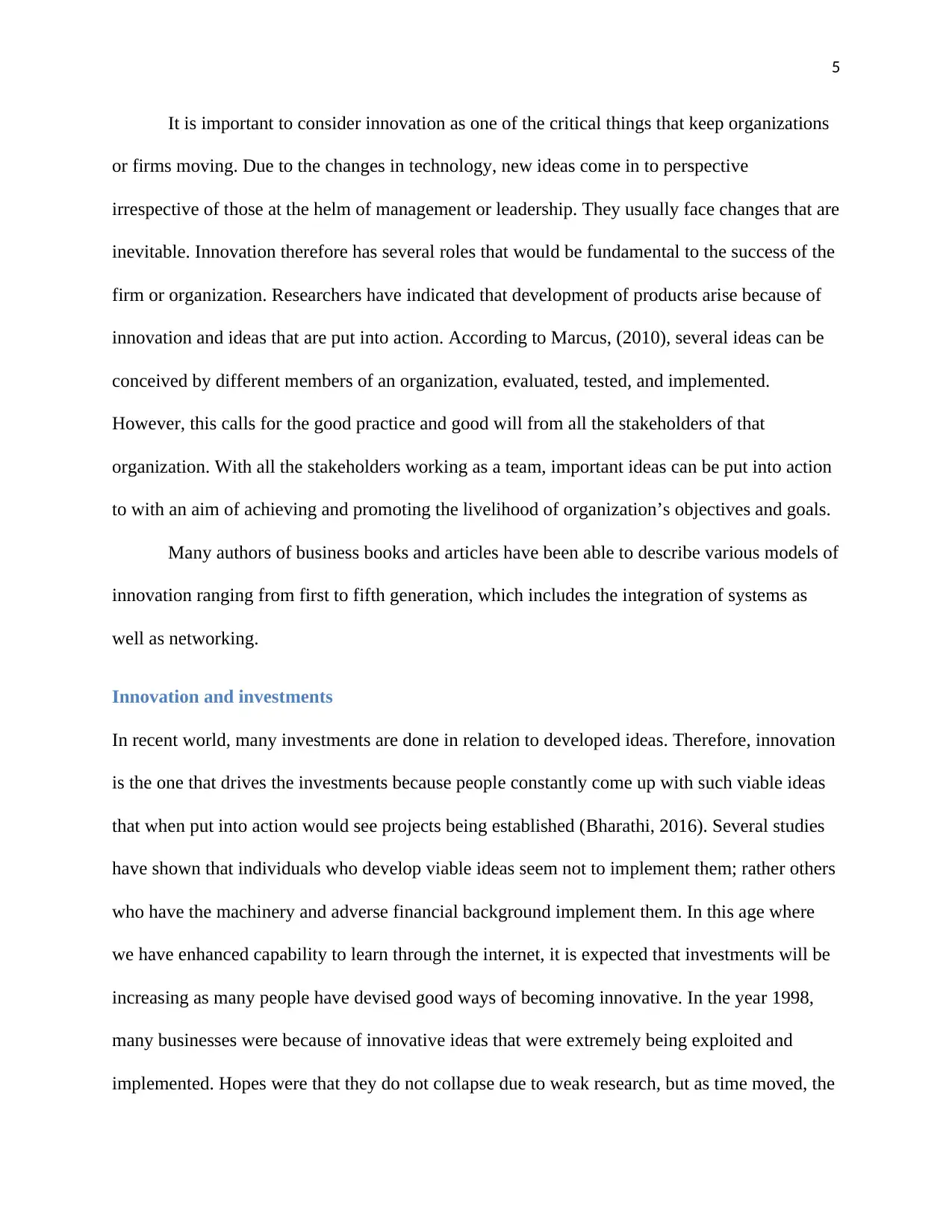
5
It is important to consider innovation as one of the critical things that keep organizations
or firms moving. Due to the changes in technology, new ideas come in to perspective
irrespective of those at the helm of management or leadership. They usually face changes that are
inevitable. Innovation therefore has several roles that would be fundamental to the success of the
firm or organization. Researchers have indicated that development of products arise because of
innovation and ideas that are put into action. According to Marcus, (2010), several ideas can be
conceived by different members of an organization, evaluated, tested, and implemented.
However, this calls for the good practice and good will from all the stakeholders of that
organization. With all the stakeholders working as a team, important ideas can be put into action
to with an aim of achieving and promoting the livelihood of organization’s objectives and goals.
Many authors of business books and articles have been able to describe various models of
innovation ranging from first to fifth generation, which includes the integration of systems as
well as networking.
Innovation and investments
In recent world, many investments are done in relation to developed ideas. Therefore, innovation
is the one that drives the investments because people constantly come up with such viable ideas
that when put into action would see projects being established (Bharathi, 2016). Several studies
have shown that individuals who develop viable ideas seem not to implement them; rather others
who have the machinery and adverse financial background implement them. In this age where
we have enhanced capability to learn through the internet, it is expected that investments will be
increasing as many people have devised good ways of becoming innovative. In the year 1998,
many businesses were because of innovative ideas that were extremely being exploited and
implemented. Hopes were that they do not collapse due to weak research, but as time moved, the
It is important to consider innovation as one of the critical things that keep organizations
or firms moving. Due to the changes in technology, new ideas come in to perspective
irrespective of those at the helm of management or leadership. They usually face changes that are
inevitable. Innovation therefore has several roles that would be fundamental to the success of the
firm or organization. Researchers have indicated that development of products arise because of
innovation and ideas that are put into action. According to Marcus, (2010), several ideas can be
conceived by different members of an organization, evaluated, tested, and implemented.
However, this calls for the good practice and good will from all the stakeholders of that
organization. With all the stakeholders working as a team, important ideas can be put into action
to with an aim of achieving and promoting the livelihood of organization’s objectives and goals.
Many authors of business books and articles have been able to describe various models of
innovation ranging from first to fifth generation, which includes the integration of systems as
well as networking.
Innovation and investments
In recent world, many investments are done in relation to developed ideas. Therefore, innovation
is the one that drives the investments because people constantly come up with such viable ideas
that when put into action would see projects being established (Bharathi, 2016). Several studies
have shown that individuals who develop viable ideas seem not to implement them; rather others
who have the machinery and adverse financial background implement them. In this age where
we have enhanced capability to learn through the internet, it is expected that investments will be
increasing as many people have devised good ways of becoming innovative. In the year 1998,
many businesses were because of innovative ideas that were extremely being exploited and
implemented. Hopes were that they do not collapse due to weak research, but as time moved, the
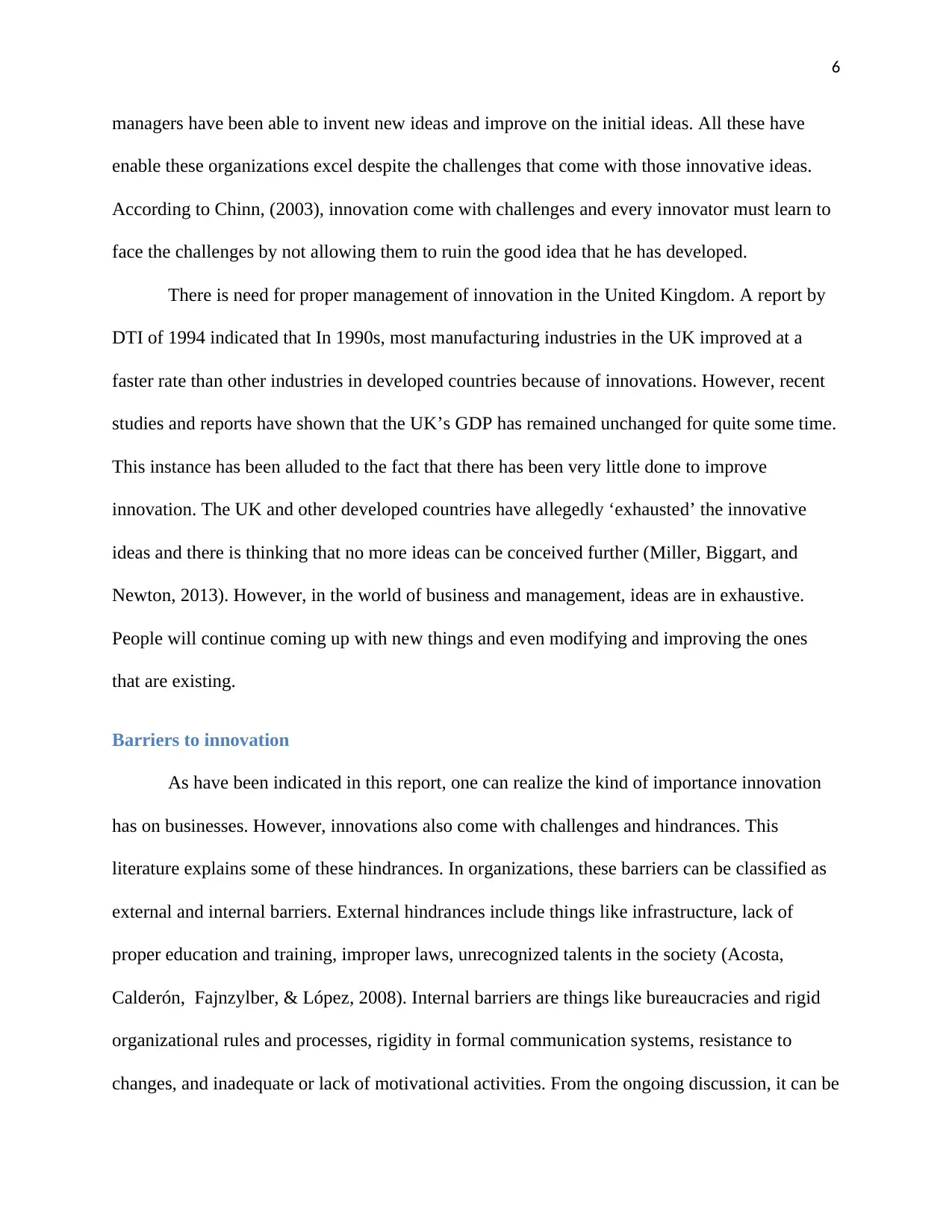
6
managers have been able to invent new ideas and improve on the initial ideas. All these have
enable these organizations excel despite the challenges that come with those innovative ideas.
According to Chinn, (2003), innovation come with challenges and every innovator must learn to
face the challenges by not allowing them to ruin the good idea that he has developed.
There is need for proper management of innovation in the United Kingdom. A report by
DTI of 1994 indicated that In 1990s, most manufacturing industries in the UK improved at a
faster rate than other industries in developed countries because of innovations. However, recent
studies and reports have shown that the UK’s GDP has remained unchanged for quite some time.
This instance has been alluded to the fact that there has been very little done to improve
innovation. The UK and other developed countries have allegedly ‘exhausted’ the innovative
ideas and there is thinking that no more ideas can be conceived further (Miller, Biggart, and
Newton, 2013). However, in the world of business and management, ideas are in exhaustive.
People will continue coming up with new things and even modifying and improving the ones
that are existing.
Barriers to innovation
As have been indicated in this report, one can realize the kind of importance innovation
has on businesses. However, innovations also come with challenges and hindrances. This
literature explains some of these hindrances. In organizations, these barriers can be classified as
external and internal barriers. External hindrances include things like infrastructure, lack of
proper education and training, improper laws, unrecognized talents in the society (Acosta,
Calderón, Fajnzylber, & López, 2008). Internal barriers are things like bureaucracies and rigid
organizational rules and processes, rigidity in formal communication systems, resistance to
changes, and inadequate or lack of motivational activities. From the ongoing discussion, it can be
managers have been able to invent new ideas and improve on the initial ideas. All these have
enable these organizations excel despite the challenges that come with those innovative ideas.
According to Chinn, (2003), innovation come with challenges and every innovator must learn to
face the challenges by not allowing them to ruin the good idea that he has developed.
There is need for proper management of innovation in the United Kingdom. A report by
DTI of 1994 indicated that In 1990s, most manufacturing industries in the UK improved at a
faster rate than other industries in developed countries because of innovations. However, recent
studies and reports have shown that the UK’s GDP has remained unchanged for quite some time.
This instance has been alluded to the fact that there has been very little done to improve
innovation. The UK and other developed countries have allegedly ‘exhausted’ the innovative
ideas and there is thinking that no more ideas can be conceived further (Miller, Biggart, and
Newton, 2013). However, in the world of business and management, ideas are in exhaustive.
People will continue coming up with new things and even modifying and improving the ones
that are existing.
Barriers to innovation
As have been indicated in this report, one can realize the kind of importance innovation
has on businesses. However, innovations also come with challenges and hindrances. This
literature explains some of these hindrances. In organizations, these barriers can be classified as
external and internal barriers. External hindrances include things like infrastructure, lack of
proper education and training, improper laws, unrecognized talents in the society (Acosta,
Calderón, Fajnzylber, & López, 2008). Internal barriers are things like bureaucracies and rigid
organizational rules and processes, rigidity in formal communication systems, resistance to
changes, and inadequate or lack of motivational activities. From the ongoing discussion, it can be
⊘ This is a preview!⊘
Do you want full access?
Subscribe today to unlock all pages.

Trusted by 1+ million students worldwide
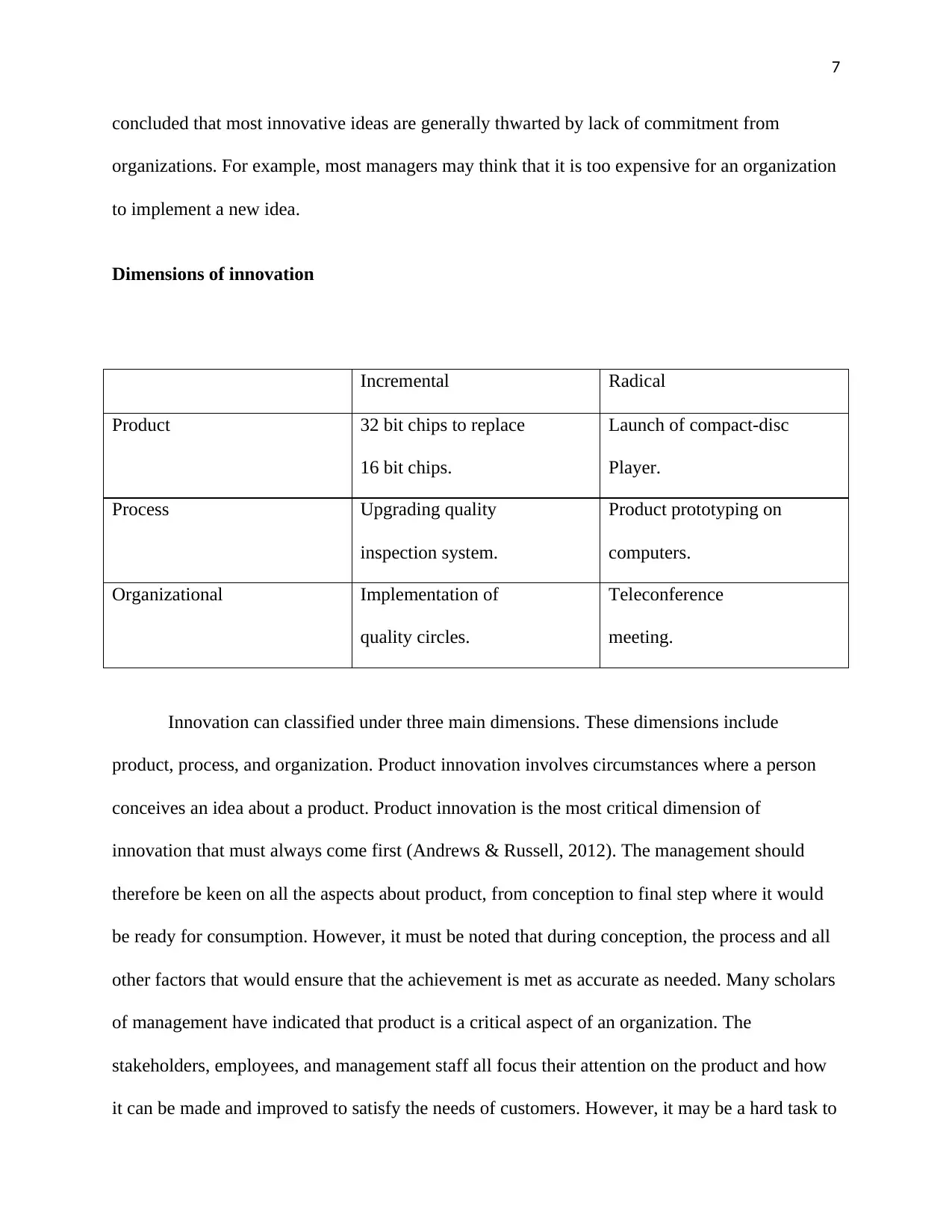
7
concluded that most innovative ideas are generally thwarted by lack of commitment from
organizations. For example, most managers may think that it is too expensive for an organization
to implement a new idea.
Dimensions of innovation
Incremental Radical
Product 32 bit chips to replace
16 bit chips.
Launch of compact-disc
Player.
Process Upgrading quality
inspection system.
Product prototyping on
computers.
Organizational Implementation of
quality circles.
Teleconference
meeting.
Innovation can classified under three main dimensions. These dimensions include
product, process, and organization. Product innovation involves circumstances where a person
conceives an idea about a product. Product innovation is the most critical dimension of
innovation that must always come first (Andrews & Russell, 2012). The management should
therefore be keen on all the aspects about product, from conception to final step where it would
be ready for consumption. However, it must be noted that during conception, the process and all
other factors that would ensure that the achievement is met as accurate as needed. Many scholars
of management have indicated that product is a critical aspect of an organization. The
stakeholders, employees, and management staff all focus their attention on the product and how
it can be made and improved to satisfy the needs of customers. However, it may be a hard task to
concluded that most innovative ideas are generally thwarted by lack of commitment from
organizations. For example, most managers may think that it is too expensive for an organization
to implement a new idea.
Dimensions of innovation
Incremental Radical
Product 32 bit chips to replace
16 bit chips.
Launch of compact-disc
Player.
Process Upgrading quality
inspection system.
Product prototyping on
computers.
Organizational Implementation of
quality circles.
Teleconference
meeting.
Innovation can classified under three main dimensions. These dimensions include
product, process, and organization. Product innovation involves circumstances where a person
conceives an idea about a product. Product innovation is the most critical dimension of
innovation that must always come first (Andrews & Russell, 2012). The management should
therefore be keen on all the aspects about product, from conception to final step where it would
be ready for consumption. However, it must be noted that during conception, the process and all
other factors that would ensure that the achievement is met as accurate as needed. Many scholars
of management have indicated that product is a critical aspect of an organization. The
stakeholders, employees, and management staff all focus their attention on the product and how
it can be made and improved to satisfy the needs of customers. However, it may be a hard task to
Paraphrase This Document
Need a fresh take? Get an instant paraphrase of this document with our AI Paraphraser
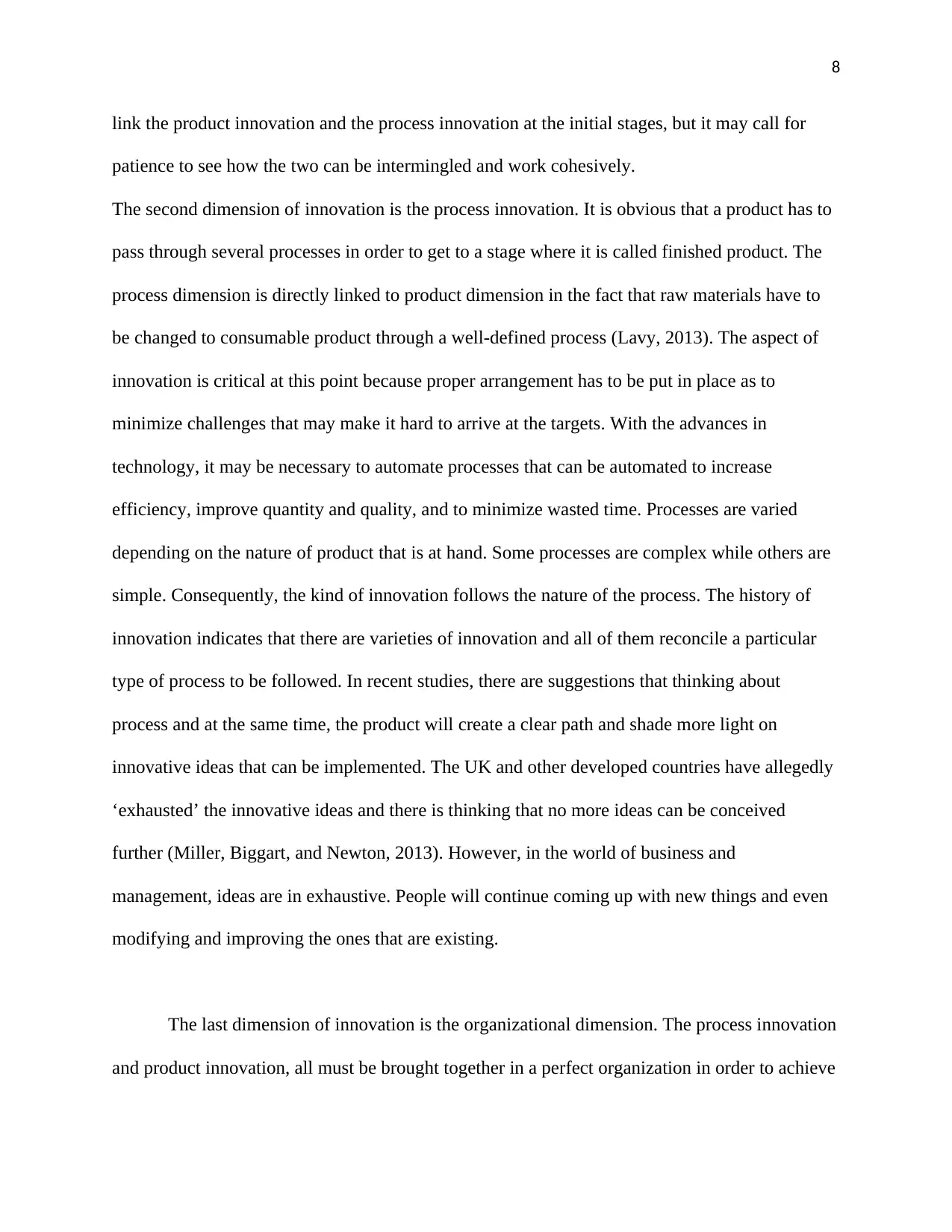
8
link the product innovation and the process innovation at the initial stages, but it may call for
patience to see how the two can be intermingled and work cohesively.
The second dimension of innovation is the process innovation. It is obvious that a product has to
pass through several processes in order to get to a stage where it is called finished product. The
process dimension is directly linked to product dimension in the fact that raw materials have to
be changed to consumable product through a well-defined process (Lavy, 2013). The aspect of
innovation is critical at this point because proper arrangement has to be put in place as to
minimize challenges that may make it hard to arrive at the targets. With the advances in
technology, it may be necessary to automate processes that can be automated to increase
efficiency, improve quantity and quality, and to minimize wasted time. Processes are varied
depending on the nature of product that is at hand. Some processes are complex while others are
simple. Consequently, the kind of innovation follows the nature of the process. The history of
innovation indicates that there are varieties of innovation and all of them reconcile a particular
type of process to be followed. In recent studies, there are suggestions that thinking about
process and at the same time, the product will create a clear path and shade more light on
innovative ideas that can be implemented. The UK and other developed countries have allegedly
‘exhausted’ the innovative ideas and there is thinking that no more ideas can be conceived
further (Miller, Biggart, and Newton, 2013). However, in the world of business and
management, ideas are in exhaustive. People will continue coming up with new things and even
modifying and improving the ones that are existing.
The last dimension of innovation is the organizational dimension. The process innovation
and product innovation, all must be brought together in a perfect organization in order to achieve
link the product innovation and the process innovation at the initial stages, but it may call for
patience to see how the two can be intermingled and work cohesively.
The second dimension of innovation is the process innovation. It is obvious that a product has to
pass through several processes in order to get to a stage where it is called finished product. The
process dimension is directly linked to product dimension in the fact that raw materials have to
be changed to consumable product through a well-defined process (Lavy, 2013). The aspect of
innovation is critical at this point because proper arrangement has to be put in place as to
minimize challenges that may make it hard to arrive at the targets. With the advances in
technology, it may be necessary to automate processes that can be automated to increase
efficiency, improve quantity and quality, and to minimize wasted time. Processes are varied
depending on the nature of product that is at hand. Some processes are complex while others are
simple. Consequently, the kind of innovation follows the nature of the process. The history of
innovation indicates that there are varieties of innovation and all of them reconcile a particular
type of process to be followed. In recent studies, there are suggestions that thinking about
process and at the same time, the product will create a clear path and shade more light on
innovative ideas that can be implemented. The UK and other developed countries have allegedly
‘exhausted’ the innovative ideas and there is thinking that no more ideas can be conceived
further (Miller, Biggart, and Newton, 2013). However, in the world of business and
management, ideas are in exhaustive. People will continue coming up with new things and even
modifying and improving the ones that are existing.
The last dimension of innovation is the organizational dimension. The process innovation
and product innovation, all must be brought together in a perfect organization in order to achieve
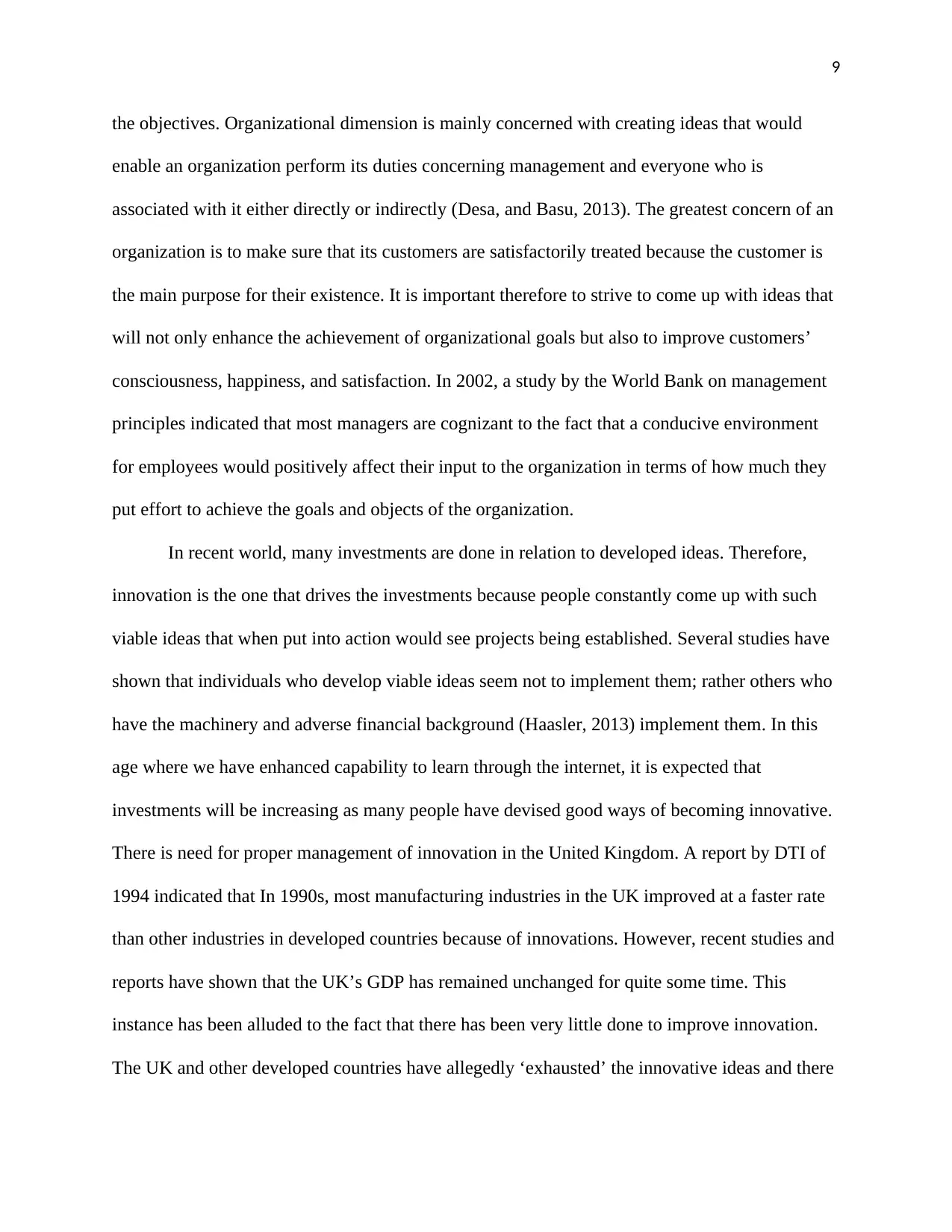
9
the objectives. Organizational dimension is mainly concerned with creating ideas that would
enable an organization perform its duties concerning management and everyone who is
associated with it either directly or indirectly (Desa, and Basu, 2013). The greatest concern of an
organization is to make sure that its customers are satisfactorily treated because the customer is
the main purpose for their existence. It is important therefore to strive to come up with ideas that
will not only enhance the achievement of organizational goals but also to improve customers’
consciousness, happiness, and satisfaction. In 2002, a study by the World Bank on management
principles indicated that most managers are cognizant to the fact that a conducive environment
for employees would positively affect their input to the organization in terms of how much they
put effort to achieve the goals and objects of the organization.
In recent world, many investments are done in relation to developed ideas. Therefore,
innovation is the one that drives the investments because people constantly come up with such
viable ideas that when put into action would see projects being established. Several studies have
shown that individuals who develop viable ideas seem not to implement them; rather others who
have the machinery and adverse financial background (Haasler, 2013) implement them. In this
age where we have enhanced capability to learn through the internet, it is expected that
investments will be increasing as many people have devised good ways of becoming innovative.
There is need for proper management of innovation in the United Kingdom. A report by DTI of
1994 indicated that In 1990s, most manufacturing industries in the UK improved at a faster rate
than other industries in developed countries because of innovations. However, recent studies and
reports have shown that the UK’s GDP has remained unchanged for quite some time. This
instance has been alluded to the fact that there has been very little done to improve innovation.
The UK and other developed countries have allegedly ‘exhausted’ the innovative ideas and there
the objectives. Organizational dimension is mainly concerned with creating ideas that would
enable an organization perform its duties concerning management and everyone who is
associated with it either directly or indirectly (Desa, and Basu, 2013). The greatest concern of an
organization is to make sure that its customers are satisfactorily treated because the customer is
the main purpose for their existence. It is important therefore to strive to come up with ideas that
will not only enhance the achievement of organizational goals but also to improve customers’
consciousness, happiness, and satisfaction. In 2002, a study by the World Bank on management
principles indicated that most managers are cognizant to the fact that a conducive environment
for employees would positively affect their input to the organization in terms of how much they
put effort to achieve the goals and objects of the organization.
In recent world, many investments are done in relation to developed ideas. Therefore,
innovation is the one that drives the investments because people constantly come up with such
viable ideas that when put into action would see projects being established. Several studies have
shown that individuals who develop viable ideas seem not to implement them; rather others who
have the machinery and adverse financial background (Haasler, 2013) implement them. In this
age where we have enhanced capability to learn through the internet, it is expected that
investments will be increasing as many people have devised good ways of becoming innovative.
There is need for proper management of innovation in the United Kingdom. A report by DTI of
1994 indicated that In 1990s, most manufacturing industries in the UK improved at a faster rate
than other industries in developed countries because of innovations. However, recent studies and
reports have shown that the UK’s GDP has remained unchanged for quite some time. This
instance has been alluded to the fact that there has been very little done to improve innovation.
The UK and other developed countries have allegedly ‘exhausted’ the innovative ideas and there
⊘ This is a preview!⊘
Do you want full access?
Subscribe today to unlock all pages.

Trusted by 1+ million students worldwide
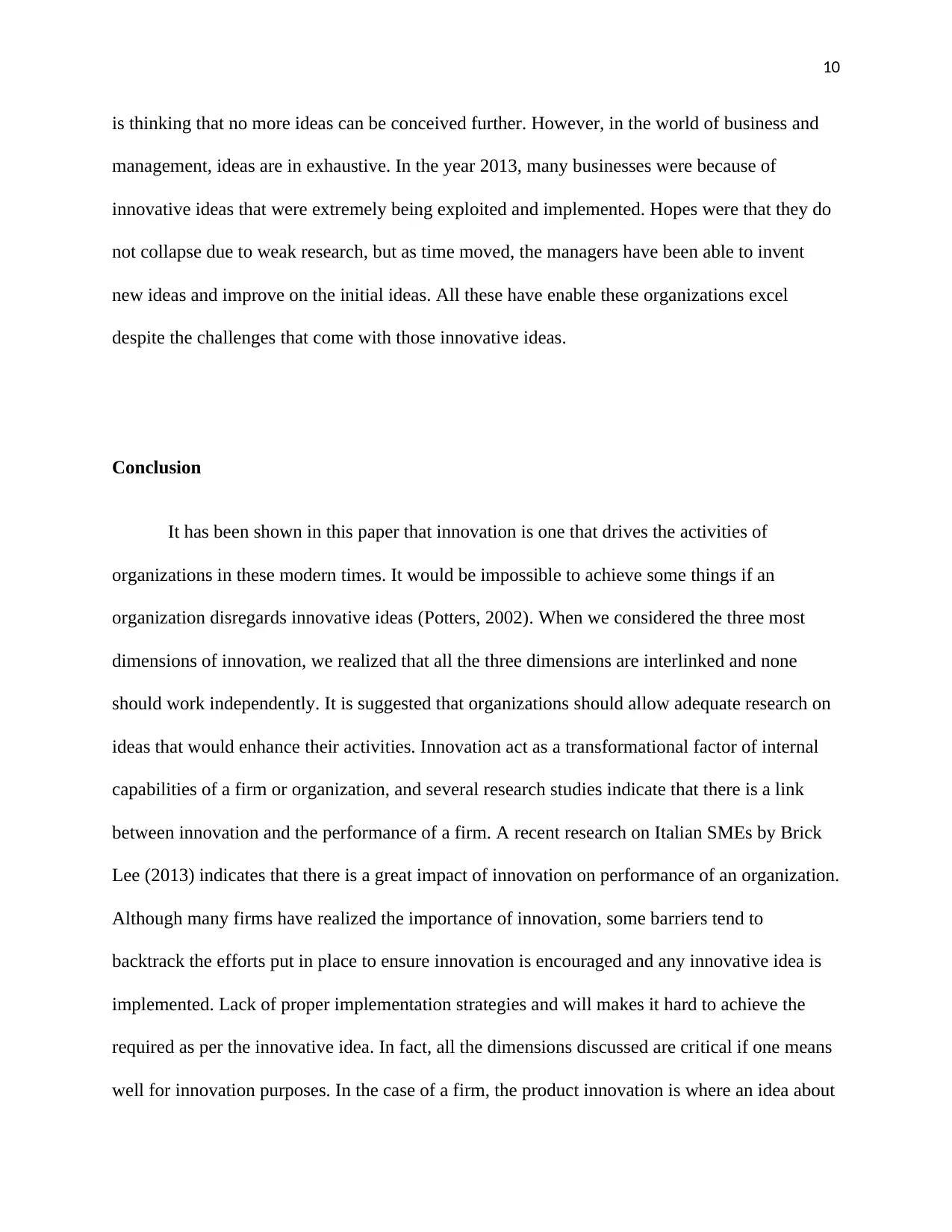
10
is thinking that no more ideas can be conceived further. However, in the world of business and
management, ideas are in exhaustive. In the year 2013, many businesses were because of
innovative ideas that were extremely being exploited and implemented. Hopes were that they do
not collapse due to weak research, but as time moved, the managers have been able to invent
new ideas and improve on the initial ideas. All these have enable these organizations excel
despite the challenges that come with those innovative ideas.
Conclusion
It has been shown in this paper that innovation is one that drives the activities of
organizations in these modern times. It would be impossible to achieve some things if an
organization disregards innovative ideas (Potters, 2002). When we considered the three most
dimensions of innovation, we realized that all the three dimensions are interlinked and none
should work independently. It is suggested that organizations should allow adequate research on
ideas that would enhance their activities. Innovation act as a transformational factor of internal
capabilities of a firm or organization, and several research studies indicate that there is a link
between innovation and the performance of a firm. A recent research on Italian SMEs by Brick
Lee (2013) indicates that there is a great impact of innovation on performance of an organization.
Although many firms have realized the importance of innovation, some barriers tend to
backtrack the efforts put in place to ensure innovation is encouraged and any innovative idea is
implemented. Lack of proper implementation strategies and will makes it hard to achieve the
required as per the innovative idea. In fact, all the dimensions discussed are critical if one means
well for innovation purposes. In the case of a firm, the product innovation is where an idea about
is thinking that no more ideas can be conceived further. However, in the world of business and
management, ideas are in exhaustive. In the year 2013, many businesses were because of
innovative ideas that were extremely being exploited and implemented. Hopes were that they do
not collapse due to weak research, but as time moved, the managers have been able to invent
new ideas and improve on the initial ideas. All these have enable these organizations excel
despite the challenges that come with those innovative ideas.
Conclusion
It has been shown in this paper that innovation is one that drives the activities of
organizations in these modern times. It would be impossible to achieve some things if an
organization disregards innovative ideas (Potters, 2002). When we considered the three most
dimensions of innovation, we realized that all the three dimensions are interlinked and none
should work independently. It is suggested that organizations should allow adequate research on
ideas that would enhance their activities. Innovation act as a transformational factor of internal
capabilities of a firm or organization, and several research studies indicate that there is a link
between innovation and the performance of a firm. A recent research on Italian SMEs by Brick
Lee (2013) indicates that there is a great impact of innovation on performance of an organization.
Although many firms have realized the importance of innovation, some barriers tend to
backtrack the efforts put in place to ensure innovation is encouraged and any innovative idea is
implemented. Lack of proper implementation strategies and will makes it hard to achieve the
required as per the innovative idea. In fact, all the dimensions discussed are critical if one means
well for innovation purposes. In the case of a firm, the product innovation is where an idea about
Paraphrase This Document
Need a fresh take? Get an instant paraphrase of this document with our AI Paraphraser
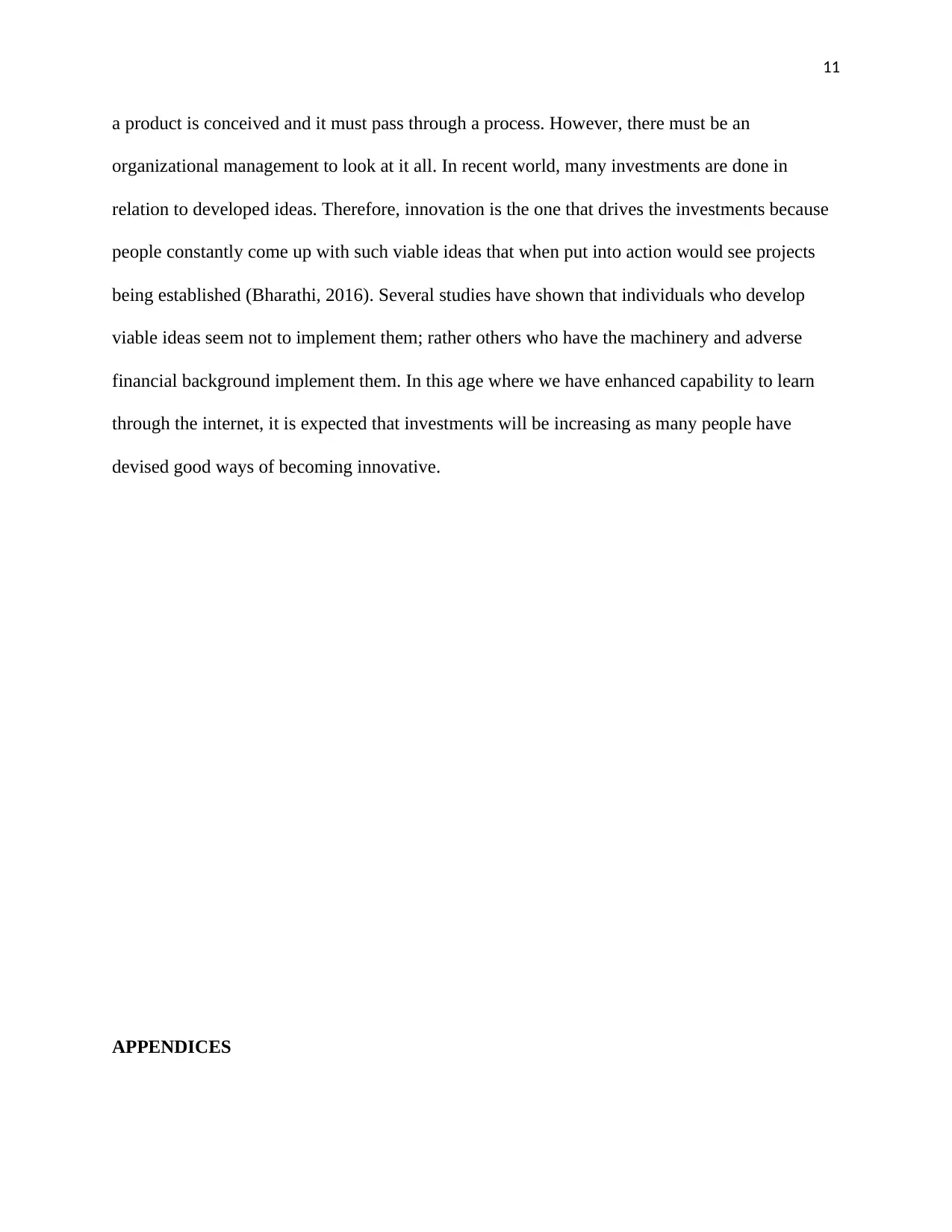
11
a product is conceived and it must pass through a process. However, there must be an
organizational management to look at it all. In recent world, many investments are done in
relation to developed ideas. Therefore, innovation is the one that drives the investments because
people constantly come up with such viable ideas that when put into action would see projects
being established (Bharathi, 2016). Several studies have shown that individuals who develop
viable ideas seem not to implement them; rather others who have the machinery and adverse
financial background implement them. In this age where we have enhanced capability to learn
through the internet, it is expected that investments will be increasing as many people have
devised good ways of becoming innovative.
APPENDICES
a product is conceived and it must pass through a process. However, there must be an
organizational management to look at it all. In recent world, many investments are done in
relation to developed ideas. Therefore, innovation is the one that drives the investments because
people constantly come up with such viable ideas that when put into action would see projects
being established (Bharathi, 2016). Several studies have shown that individuals who develop
viable ideas seem not to implement them; rather others who have the machinery and adverse
financial background implement them. In this age where we have enhanced capability to learn
through the internet, it is expected that investments will be increasing as many people have
devised good ways of becoming innovative.
APPENDICES
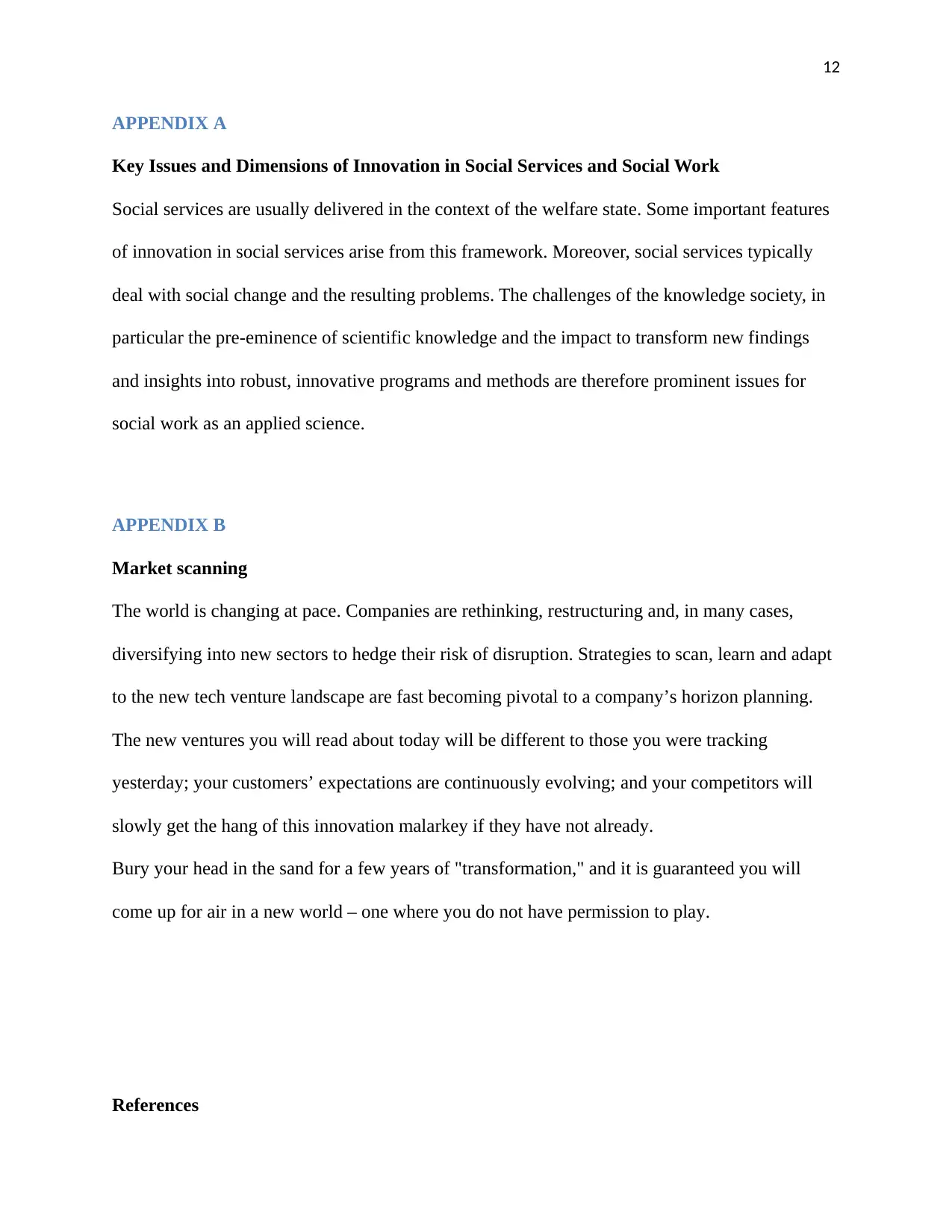
12
APPENDIX A
Key Issues and Dimensions of Innovation in Social Services and Social Work
Social services are usually delivered in the context of the welfare state. Some important features
of innovation in social services arise from this framework. Moreover, social services typically
deal with social change and the resulting problems. The challenges of the knowledge society, in
particular the pre-eminence of scientific knowledge and the impact to transform new findings
and insights into robust, innovative programs and methods are therefore prominent issues for
social work as an applied science.
APPENDIX B
Market scanning
The world is changing at pace. Companies are rethinking, restructuring and, in many cases,
diversifying into new sectors to hedge their risk of disruption. Strategies to scan, learn and adapt
to the new tech venture landscape are fast becoming pivotal to a company’s horizon planning.
The new ventures you will read about today will be different to those you were tracking
yesterday; your customers’ expectations are continuously evolving; and your competitors will
slowly get the hang of this innovation malarkey if they have not already.
Bury your head in the sand for a few years of "transformation," and it is guaranteed you will
come up for air in a new world – one where you do not have permission to play.
References
APPENDIX A
Key Issues and Dimensions of Innovation in Social Services and Social Work
Social services are usually delivered in the context of the welfare state. Some important features
of innovation in social services arise from this framework. Moreover, social services typically
deal with social change and the resulting problems. The challenges of the knowledge society, in
particular the pre-eminence of scientific knowledge and the impact to transform new findings
and insights into robust, innovative programs and methods are therefore prominent issues for
social work as an applied science.
APPENDIX B
Market scanning
The world is changing at pace. Companies are rethinking, restructuring and, in many cases,
diversifying into new sectors to hedge their risk of disruption. Strategies to scan, learn and adapt
to the new tech venture landscape are fast becoming pivotal to a company’s horizon planning.
The new ventures you will read about today will be different to those you were tracking
yesterday; your customers’ expectations are continuously evolving; and your competitors will
slowly get the hang of this innovation malarkey if they have not already.
Bury your head in the sand for a few years of "transformation," and it is guaranteed you will
come up for air in a new world – one where you do not have permission to play.
References
⊘ This is a preview!⊘
Do you want full access?
Subscribe today to unlock all pages.

Trusted by 1+ million students worldwide
1 out of 14
Related Documents
Your All-in-One AI-Powered Toolkit for Academic Success.
+13062052269
info@desklib.com
Available 24*7 on WhatsApp / Email
![[object Object]](/_next/static/media/star-bottom.7253800d.svg)
Unlock your academic potential
Copyright © 2020–2025 A2Z Services. All Rights Reserved. Developed and managed by ZUCOL.





